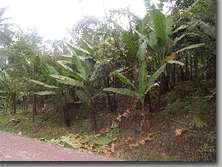 Methods and
Processes
A. Building Internal Capability
- Trainings in social education that
included courses in self-awareness, group building, cooperativism, organizational
strengthening, and rural leadership.
Two phases of social education are
required for prospective members. The first phase is on self-awareness and group building,
followed by rural leadership skills training for the second phase.
Phase 1
This process enabled the
farmer-member to know oneself better by doing an in-depth examination of the
individual’s assets and liabilities, identifying strengths and weaknesses, and
capacitating oneself to relate with others. Through this training, they were able to
clearly understand the importance of oneself in relation to others in a group; appreciate
better the various factors related to sharing, involvement, participation, and cooperation
through team building, thus, strengthening the group’s capabilities. The training
also gave them tips on how to work with others successfully. In this manner, it helped
them identify the prerequisites for a successful cooperative endeavor, as well as
demonstrate techniques in establishing rapport with other community residents actively
participating in community affairs for rural development. The training is anchored on
human values, interpersonal relations, and value clarification and orientation.
Phase II
This phase of the capability
building training enabled the participants to know and understand concepts and principles
of leadership including defining what a leader is in operational terms. This included
identifying the qualities, characteristics, and traits of a good leader. The leadership
development training provided an atmosphere of group cohesiveness accruing from the
leadership styles as manifested by the leader in leading a clientele community. All
members have to attend this training to prepare them for leadership positions in the
association. Thus, in the very unlikely event of a vacancy in any position, any qualified
member can automatically succeed with ease and confidence.
- Drafting of TOFA’s constitution
and by-laws and set goals and projects
Upon organization of the TOFA, the
members with assistance from the PNOC-EDC extension staff drafted the TOFA’s
constitution and by-laws, and set goals and projects. Rules and regulations regarding
membership, project management, and profit sharing have been set and are being strictly
enforced. They also formulated policies for each sector, adding new ones through assembly
resolutions to address problems or experiences that occasionally arise.
In their membership guidelines, it
is stipulated that membership is limited to farmer-residents of Tongonan and Nueva Vista.
The minimum age limit was set to be 16 years old. The membership fee is P10.00.
Although family members are
encouraged to join the association, children are told to prioritize their schooling. Thus,
they can only render work for the association during vacation time, weekends, or on
holidays. Membership is continually strengthened especially since it sustains the life of
the association.
The association holds its general
meetings on the first Wednesday of the month. For those who are either absent or late for
three consecutive meetings a fine of P50.00 is charged which is added to the CBU. Every
meeting, one peso is collected from each member for their emergency funds.
Internal structure
Since the organization had to take
care of multi-faceted concerns, internal structures had to be institutionalized. Two
umbrella organizations were formed to better manage TOFA’s projects: The TOFA
Women’s League and the TOFA Youth Organization. Further, for their labor-contracts
with the PNOC, the association divided themselves into seven groups with a supervisor each
to oversee their activities and manage the workers. Uniform wages for their work in the
plantation are given to the members, regardless of sex and age. On two Saturdays every
month, members are required to render service to the association-sponsored pintakasi.
On these days, they do not receive their wages but are instead donated directly to the CBU
funds.
- Institution and administration of the
Capital Build-Up Fund
A Capital Build-Up Scheme was
instituted in the TOFA to strengthen the association’s financial capability in
preparation for self-sustainability. The CBU is derived from a voluntary deduction of 10
percent from the members’ daily wages, revenues earned by the organization from
various livelihood projects, and those wages intended for pintakasi
services. Fines collected from various offenses of erring members also go to the CBU.
At the end of 1997, TOFA’s CBU
has reached P796,203.00 while its net worth increased to P1,570,664.00 with no liability.
TOFA’s fixed assests now total P423,727.00.
The association’s funds are
safely deposited in several banks. As a safeguard from being misused, cash withdrawals are
not honored without the signatures of the president and the treasurer of TOFA and the
PNOC-EDC extension officer.
B. Linkages with other
Agencies
Being a legitimate association, TOFA
has firmed up strong linkages with government agencies such the DENR, DOLE, LGUs and the
DSWD, among others. In its day to day operation, it has also established linkages with
non-government organizations and some research and academic institutions.
C. Livelihood/Income
Generation
TOFA’s main income is derived
from two main sources: (a) agroforestry and rattan plantation; and (b) labor contracting
work with PNOC-EDC. TOFA aimed to establish 1000 hectares of rattan plantation which when
achieved would be the second largest rattan plantation in the country. At the end of 1997,
TOFA was able to establish a total of 638 hectares of rattan and 150 hectares of
agroforestry.
Rattan seedlings are planted at 3m X
3m spacing (1100 stems/ha.) On the first year of harvest, projected yield per hectare is
3,300 rattan poles or 330,000 poles per 100 hectares if done on a rotation basis. At an
assumed current selling rate of P30/pole, TOFA is expected to gross P9,900,000.00 a year
which is quite a considerable income for a farmers group of 178 members.
TOFA has also established 25
hectares of Acacia mangium planted at 10m between rows and 1m within the row. This
module aims to provide shelter, improve the soil, and provide forest cover so that
intercrops of jackfruit, mango, and citrus may be established. It is expected that the
harvests of acacia will have a good market because of the scarce supply of logs and
lumber, coupled with the increasing demand from the construction, shipping, wood
processing industries and other wood-dependent downstream manufacturers.
 The association engages in other economic activities while waiting for
harvest time. They operate a savings and loan venture with an initial capitalization of
P200,000.00 taken from their CBU. They also put up a consumer’s store, a
mini-canteen/catering business, a home-movie business, and benefit dances. They have also
ventured into planting abaca and banana, and are raising livestock such as pigs, goats,
and carabaos. The association engages in other economic activities while waiting for
harvest time. They operate a savings and loan venture with an initial capitalization of
P200,000.00 taken from their CBU. They also put up a consumer’s store, a
mini-canteen/catering business, a home-movie business, and benefit dances. They have also
ventured into planting abaca and banana, and are raising livestock such as pigs, goats,
and carabaos.
basic info
| initiative
| strategy
| critical factors
| other links
| home
|

